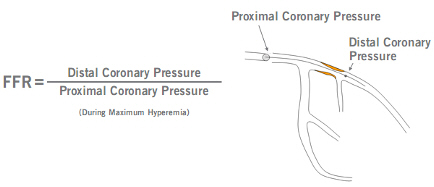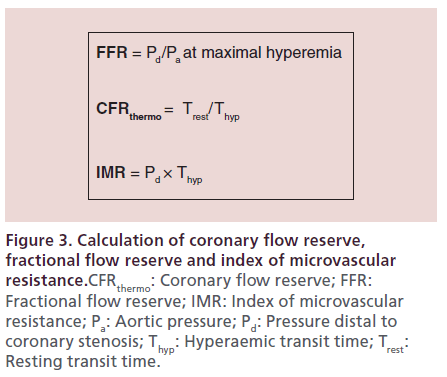fractional flow reserve formula
Clinicians are increasingly relying on this method because it is independent of baseline flow relatively simple and. 321 FFR Q s Q n.
Process Of Computational Fractional Flow Reserve Ffr Calculation A Download Scientific Diagram
It is calculated using the pressure ratio where is the pressure distal to the lesion and is.

. The aim of this study was to investigate the epicardial and microvascular substrates associated with discordances between fractional flow reserve FFR and coronary flow reserve CFR values. An FFR of 10 is widely accepted as normal. However studies have shown that if a functional measurement such as FFR shows that the flow is.
Coronary stenosis severity and lesion-level ischaemia can be assessed invasively based on the myocardial fractional flow reserve FFR resting distal coronary pressure to aortic pressure ratio PdPa during hyperaemia and the ischaemic threshold 080 223132 see Figure 1. This study aims to identify the relation between the FFR and the degree of coronary arterial stenosis using a simple mathematical. Fractional flow reserve is calculated as the ratio of the maximum blood flow distal to the stenosis divided by the maximum flow proximal to the stenosis.
Fractional flow reserve FFR measurement involves determining the ratio between the maximum achievable blood flow in a diseased coronary artery and the theoretical maximum flow in a normal coronary artery to determine the likelihood that the stenosis impedes oxygen delivery to the heart muscle. Fractional flow reserve FFR is a physiological index of the severity of a stenosis in an epicardial coronary artery based on the pressure differential across the stenosis. The aim of this study was to compare the changes of fractional flow reserve FFR or instantaneous wave-free ratio iFR with severity of epicardial coronary stenosis between nonculprit vessel of acute myocardial infarction AMI and stable ischemic heart disease SIHD.
Fractional flow reserve FFR and instantaneous wave-free ratio iFR are the two most commonly used coronary indices of physiological stenosis severity based on pressure. Corrected FFR for the proximal left and distal right lesions as a function of Pw. Fractional Flow Reserve FFR offers yet another tool to assist in identification of those intermediate blockages.
In patients with an indication for FFR and sequential coronary stenosis FFR was recorded distally and between the lesions. J-shape of Pijls formula to calculate fractional flow reserve FFR in sequential lesions as a function of coronary wedge pressure Pw. The function has been represented in four different combinations of PaPd measured distally and between the lesions.
There has been debate regarding the reliability of FFR or iFR for nonculprit. The FFR is calculated as the ratio of the maximum flow in a stenosed epicardial vessel Q s after reaching maximum vasodilatation to the theoretical maximum flow of the same vessel in the same maximum vasodilatation conditions without the stenosis Q n. FFR is defined as a ratio of the maximal myocardial blood flow in the presence of a stenosis to the theoretical normal.
J-shape of Pijls formula to calculate fractional flow reserve FFR in sequential lesions as a function of coronary wedge pressure Pw. This translesional pressure ratio during maximum flow expresses the functional significance of a coronary lesion. The FFR is calculated as the ratio of the maximum flow in a stenosed epicardial vessel Q s after reaching maximum vasodilatation to the theoretical maximum flow of the same vessel in the same maximum vasodilatation conditions without the stenosis Q n.
FFR hyperemic stenosis resistance HSR and intravascular. 321 FFR Q s Q n. Background and objectives.
FFR stands for fractional flow reserve and is a measure of resistance in the epicardial conductance coronary arteries. Discordances between FFR and CFR remain poorly characterized. Multiple methods for non-invasively calculating fractional flow reserve FFR have been developed based on coronary computed tomography angiography CCTA images and all have been reported to add an incremental diagnostic value to conventional CCTA using invasive FFR as a reference 123456However variations have been reported in.
A simplified formula to calculate the predicted fractional flow reserve FFR in sequen-tial coronary stenosis without balloon inflation is hereby proposed. To minimize the effect of wedge pressure P wedge FFR is measured during hyperemia conditions and iFR is calculated as the ratio of distal and aortic. The myocardial fractional flow reserve FFR is clinically used as a stenosis-specific indexAim.
The goal of angioplasty and stenting in the coronary arteries is to increase blood flow to the heart and in turn relieve chest pain. The predicted FFR for each stenosis was calculated with a novel formu-la.

Rfrist Study Fractional Flow Reserve In Functional Quantification Of Renal Allograft Artery Stenosis Rationale And Study Design Revista Brasileira De Cardiologia Invasiva English Edition

Fractional Flow Reserve Ct In A 61 Year Old Male With Typical Angina Download Scientific Diagram

Fractional Flow Reserve An Overview Sciencedirect Topics

Fractional Flow Reserve Coronary Flow Reserve Imr Microvascular Resistance

Fractional Flow Reserve Ffr In The Presence Of Serial Stenoses In A Download Scientific Diagram

Fractional Flow Reserve Coronary Flow Reserve Imr Microvascular Resistance

Fractional Flow Reserve Ffr In The Presence Of Serial Stenoses In A Download Scientific Diagram

Theoretical Expressions Of Ffr And Cfr Ffr Can Be Expressed As A Download Scientific Diagram

Fractional Flow Reserve Concepts Applications And Use In France In 2010 Thoracic Key

Impact Of Hydrostatic Pressure On Fractional Flow Reserve In Vivo Experimental Study Of Anatomical Height Difference Of Coronary Arteries Journal Of Cardiology

Fractional Flow Reserve Ffr Cathlab Com

The Impact Of Virtual Fractional Flow Reserve And Virtual Coronary Intervention On Treatment Decisions In The Cardiac Catheter Laboratory Canadian Journal Of Cardiology

Accuracy Of Intravascular Ultrasound Based Fractional Flow Reserve In Identifying Hemodynamic Significance Of Coronary Stenosis Circulation Cardiovascular Interventions

Fractional Flow Reserve Coronary Flow Reserve Imr Microvascular Resistance

Virtual Resting Pd Pa From Coronary Angiography And Blood Flow Modelling Diagnostic Performance Against Fractional Flow Reserve Heart Lung And Circulation

Fractional Flow Reserve Ffr Established Measures Grepmed

Fractional Flow Reserve To Guide Coronary Revascularization Semantic Scholar

Current Frontiers In The Clinical Research Of Coronary Physiology